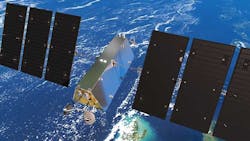Doug Mohney is the Editor in Chief of Space IT Bridge, which tracks the business of space-based satellites. He has been working in and writing about IT and satellite industries for over 20 years.
SpaceX, OneWeb, Telesat and Amazon are all moving forward with plans to deliver low-latency high speed broadband across the globe, leveraging the advantages of low Earth orbit (LEO) satellites. Both SpaceX and OneWeb are filling out their constellations of hundreds and thousands of spacecraft this year, while Telesat and Amazon plan to start launching their first satellites within two to three years.
These new networks will be tied into terrestrial data networks through data centers and interconnection meet-me-points, an essential step to reduce latency and boost performance for applications requiring rapid responsiveness, such as real-time communications, gaming, and financial services.
“We’ve been approached by multiple parties to put dishes on our roof and/or interconnect and have done so for years,” said Jim Poole, Vice President of Business Development at Equinix. “It’s primarily an issue of managing space, weight, and interference. A clear sky view is always necessary.”
Equinix is seeing increasing interest from satellite operators than in years past, due in part to the emergence of newer LEO services. Poole said the average port speed being requested by LEO broadband providers asking to interconnect is typical a multiple of 10G.
But cloud service providers are also forming deeper partnerships with satellite broadband services, and Amazon is planning to operate its own LEO network. What are these newcomers bringing to the table?
Available now – SpaceX Starlink
SpaceX’s rollout of its Starlink low Earth orbit (LEO) satellite broadband service is winning enthusiastic fans among over 10,000 participants in its “Better than Nothing” beta, with founder and CEO Elon Musk indicating a need for Starlink to connect into data centers and interconnect points for high-speed low latency services to support online gaming and other services.
Starlink is the farthest along of the four major LEO broadband providers. With over 1,000 satellites in orbit as of February 13, 2021, users are seeing downlink speeds of 100 Mbps or better, uplink speeds of up to 20 Mbps, and latencies below 32 milliseconds for 95% of network round trip according to a Federal Communications Commission (FCC) filing.
A SpaceX Starlink dish at a Tesla charging station for EV cars. (Photo: Eric Rosenberry)
To deliver 24×7 global coverage, SpaceX must put 1,440 satellites into orbit. The company plans to conduct an average of two launches per month this year with around 60 satellites per launch, putting it on a pace to deliver global coverage by mid to late 2021. Future satellites will incorporate laser crosslinks to reduce dependencies on ground station relays and decrease latency. SpaceX has FCC approval to operate up to 12,000 Starlink satellites and is seeking permissions to add 30,000 more on top of that.
As it continues its large-scale direct to consumer (D2C) effort, Starlink is now accepting worldwide pre-orders on its website for a $99 down payment. Beta customers are currently paying $499 for the Starlink dish and router and $99 per month for the service with no data caps. As of mid-February, Starlink dishes have been deployed in the United States, Canada, the UK, and Germany. SpaceX is licensed by the FCC to operate up to one million Starlink consumer dishes and is seeking to boost that to 5 million based on initial beta interest.
The new Microsoft Azure Modular Data Center (MDC), which includes satellite connectivity. (Photo: Microsoft)
In October 2020, Microsoft announced it would partner with SpaceX to connect its customers, Azure data centers and Azure Modular Data Center (MDC), providing direct connectivity for remote locations and MDC-based edge computing, providing high-speed broadband in places where there’s no alternative and a backup connection for those that do. FCC filings, news reports, and interviews with Starlink customers indicate the company is working with the U.S. military, local governments and school districts, and oil and gas firms.
Playing catchup – OneWeb
OneWeb has had a significant delay on its LEO broadband satellite network, with launches and satellite construction put on hold for much of 2020 after filing for bankruptcy in March. Operations restarted in November 2020 when it secured financial support from the UK government, the Bharti telecom group, and satellite equipment manufacture Hughes Network Systems.
The company has 110 of its initially planned 648 satellites in orbit as of mid-February and is planning to launch 34 to 36 at a time monthly throughout 2021 and into 2022. Initial service to Canada, the UK, Alaska and the polar regions is expected by the end of this year, with global service available in 2022.
Initial testing of the OneWeb broadband service showed it can provide up 200 Mbps downlink and 50 Mbps uplinks speeds, with the potential to provide more bandwidth through a combination of software and RF encoding upgrades. Founder Greg Wyler believes with adjustments, gigabit-class downstream speeds are possible. The company is seeking to expand its constellation to nearly 7,000 satellites in the future.
OneWeb hasn’t announced any partnerships with cloud providers or carrier interconnection agreements, but its relationship with Bharti will likely guide and facilitate where and how it connects with data centers and at interconnection facilities. The company is pursuing customers in the maritime, aviation, enterprise, and government sectors, along with cellular backhaul. Unlike SpaceX, OneWeb has no plans to pursue a direct-to-consumer strategy currently.
The Experienced Operator – Telesat
Canadian-based Telesat is unique among LEO providers as an established satellite operator with a fleet of geosynchronous Earth orbit (GEO) satellites. On February 9, 2021, it announced a $3 billion contract with Thales Alena Space to build a fleet of 298 satellites and a supporting ground network for its Lightspeed LEO broadband network.
A Telesat landing station for low-earth orbit satellite transmission. (Photo: Telesat)
Each satellite will have four dedicated laser communications crosslinks to provide a faster on-network path for customers that need it, routing packets from satellite-to-satellite in a straight line rather than adding network hops and fiber transit time through terrestrial infrastructure.
Telesat is specifically focusing on enterprise customers in verticals of fixed and mobile network operators, aeronautical and maritime users, enterprise customers and governments. It expects to launch its first satellites in approximately two years with commercial services commencing in the second half of 2023. The Canadian government is a key stakeholder in the project, agreeing to provide nearly $500 million in financial support over 10 years to provide universal broadband connectivity to communities across Canada.
Broadband speeds will be dependent upon dish size and what customers are willing to pay for, but Telesat believes it will be able to deliver up to 7.5 Gbps to a single dish and 20Gbps or more to “hot spot areas” such as rural communities, airports, and seaports where users are concentrated.
Interconnection is a major part of the Telesat satellite network build moving forward. “We’ll be building a global ground network to interconnect at major data centers, at major carrier hotels or internet exchange points because that’s where our customers will take the traffic out,” said Manik Vinnakota, Telesat Director of Product and Commercial (Global).”
“We’ll be building a global ground network to interconnect at major data centers, at major carrier hotels or Internet exchange points.”
Telesat’s Manik Vinnakota
Telesat will be constructing 20 to 30 landing stations around the world consisting of 10 to 15 3.5-meter antennas and associated equipment outside of urban areas, then using dedicated fiber to reach the necessary data centers and Internet exchange points. Customers concerned with extremely low latency, such as high-frequency traders and gaming, will be able to put a dish directly on their rooftop, bypassing terrestrial bottlenecks and slight delays introduced by optical signals passing through glass as compared to the vacuum of space.
Vinnakota says 100 milliseconds round trip latency seems to be the rough boundary for users choosing between backhauling edge data into the cloud for processing and edge computing. “What we’re seeing is more than 95% of the traffic is being sent back and its fine,” Vinnakota stated. “Very few cases will get processed at the edge.”
A $10 Billion Commitment – Amazon Project Kuiper
Only a few basic facts are known about Amazon’s LEO broadband plans, dubbed Project Kuiper. The constellation will be made up of 3,236 satellites and cost at least $10 billion. Like SpaceX Starlink, Amazon says it will use the network to provide services directly to consumers, providing affordable broadband services to underserved communities around the world. It will also support backhaul solutions for wireless carriers to extend cellular services to new regions in the U.S. and around the world.
Amazon is no stranger to satellite operations, having launched AWS Ground Station to provide a single-point-of-contact in operating satellites and processing the data collected from them. There’s big money in satellite imaging, with hundreds of terabytes per month coming down from satellites.
The FCC has just approved Project Kuiper, Amazon’s $10 billion plan to deploy a satellite broadband service. (Image: and Logo: Amazon)
Project Kuiper has not announced when it will launch its first satellites but needs to have half of its constellation in orbit by 2026 to meet its current FCC license obligations. Like SpaceX and Telesat, Kuiper satellites will have laser crosslinks to reduce latencies and dependence upon ground station relays.
Amazon has made progress in lower-cost phased array antenna design, announcing in December via blog post engineers had completed initial development on a 30 centimeter wide dish prototype capable of 400 Mbps downlink speeds. In comparison, the Space Starlink dish is 54 centimeters wide and has an estimated production price of $2400; no estimate on how much a ready-to-ship Project Kuiper antenna might cost, but a smaller dish translates to lower manufacturing costs.
A LEO future in flux
Ever-optimistic SpaceX founder Elon Musk recognizes there are substantial financial and businesses challenges ahead for Starlink and other services. “SpaceX needs to pass through a deep chasm of negative cash flow over the next year or so to make Starlink financially viable,” Musk tweeted on February 2, 2020. “Every new satellite constellation in history has gone bankrupt. We hope to be the first that does not.”
Is there enough business to support multiple LEO broadband networks? Clearly, Amazon believes so and has the free cash flow to support Project Kuiper to completion. Telesat’s $5 billion enterprise-focused Lightspeed network has the commitment of the company and a combination of cash, financing, and proceeds from a future IPO to make it happen. But funding commitments don’t equal customer contracts or translate to average revenue per user.
Higher broadband speeds will require more and probably larger satellites for some operators. SpaceX has a large logistical challenge as it scales from its initial 1,440 satellites up to 12,000. In one of its latest FCC filings, SpaceX suggested Starlink will support speeds up to 10 Gbps. Similarly, OneWeb would have to find the money to move beyond its current 648 satellites to produce and launch more than 10 times as many if it is to reach the numbers it has requested from the FCC.
However, Musk left open the door for hope in a follow-up tweet. “Once we can predict cash flow reasonably well, Starlink will IPO.”







